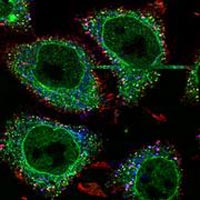In vivo, in vitro, in silico – rule of three for Systems Biology

Prof. Marino Zerial searches after visualisation of cell organells, to make them accesible for modeling with the computer Photo: M. Zerial <br>"Reprinted from Cell, Vol.116 , Authors: M. Zerial, Miaczynska, Title of article: APPL Proteins Link Rab5, Pages 445 - 456, Copyright 06.02.2004 with permission from Elsevier
Prof. Jens Reich, Biomathematician and member of the German National Ethics Council, is one of the scientists within the Systems Biology competence network HepatoSys* who is on the scent of a major mystery of life. His main concern is the question how biological systems with a vast number of subprocesses can function. In order to understand the linkages, identifying agents such as proteins and encymes does not suffice. Of equal importance is the exploration of their interdependency.
The close collaboration between scientists working in experimental medicine and biology with theorists doing computer modeling in mathematics, physics and engineering sciences has already stood the test. Two years after the launch of the BMBFs funding focus Systems Biology, the networkers of HepatoSys have placed an initial milestone on the way to a virtual liver cell. The aim to reproduce physiological processes not only in vivo (in living organisms) and in vitro (in the test tube), but also in silico** (in the computer), has come closer.
First results
The scientists have succeeded in building a mathematical model of the socalled JAK-STAT signal cascade which contributes to the regulation of both the development and the growth control in mammalian cells. With the help of this model they can predict how fast single steps in signal transduction will take place. Surprisingly, the signal pathway is not linear but occurs in a cyclical manner which is the base for a finely tuned signal transduction.
„The analysis in hepatocytes shows that this principle is universally valid for the JAK-STAT signal pathway. As opposed to conventional approaches, our in silico analyses illustrate that stages of the molecule transport into and out of the nucleus are best suited for an inhibition of signal transduction“ explains Dr. Ursula Klingmüller of the HepatoSys network Regeneration. Predictions developed with the help of computers could be validated experimentally. This way, by using the Systems Biology approach, valuable information regarding biological questions can be gathered. They can be used beyond liver cell research, e.g. in the development of cancer medication.
The Vision
Systems Biology is effective yet still at the beginning. Clinical application is a long way ahead says Prof. Timmer, scientific speaker of HepatoSys. „It is our longterm goal to advance medicine from a qualitative, descriptive research discipline to a quantitatively predictive research discipline.“
* HepatoSys: a neologism combining Hepatocyte – liver cell – and Systems Biology
** in silico: named after the chemical element silicon which is the base for the production of computer chips. In Systems Biology, the term means the evaluation and graphical display of experimentally gained computer data.
Contact:
Dr. Ute Heisner
HepatoSys –
Network Systems Biology
Project Management
Institute for Physics
University Freiburg
Phone: +49 – (0)761 – 203 5803
Fax: +49 – (0)761 – 203 5967
Email: ute.heisner@fdm.uni-freiburg.de
Media Contact
Weitere Informationen:
http://www.systembiologie.deAlle Nachrichten aus der Kategorie: Biowissenschaften Chemie
Der innovations-report bietet im Bereich der "Life Sciences" Berichte und Artikel über Anwendungen und wissenschaftliche Erkenntnisse der modernen Biologie, der Chemie und der Humanmedizin.
Unter anderem finden Sie Wissenswertes aus den Teilbereichen: Bakteriologie, Biochemie, Bionik, Bioinformatik, Biophysik, Biotechnologie, Genetik, Geobotanik, Humanbiologie, Meeresbiologie, Mikrobiologie, Molekularbiologie, Zellbiologie, Zoologie, Bioanorganische Chemie, Mikrochemie und Umweltchemie.
Neueste Beiträge

Anlagenkonzepte für die Fertigung von Bipolarplatten, MEAs und Drucktanks
Grüner Wasserstoff zählt zu den Energieträgern der Zukunft. Um ihn in großen Mengen zu erzeugen, zu speichern und wieder in elektrische Energie zu wandeln, bedarf es effizienter und skalierbarer Fertigungsprozesse…

Ausfallsichere Dehnungssensoren ohne Stromverbrauch
Um die Sicherheit von Brücken, Kränen, Pipelines, Windrädern und vielem mehr zu überwachen, werden Dehnungssensoren benötigt. Eine grundlegend neue Technologie dafür haben Wissenschaftlerinnen und Wissenschaftler aus Bochum und Paderborn entwickelt….

Dauerlastfähige Wechselrichter
… ermöglichen deutliche Leistungssteigerung elektrischer Antriebe. Überhitzende Komponenten limitieren die Leistungsfähigkeit von Antriebssträngen bei Elektrofahrzeugen erheblich. Wechselrichtern fällt dabei eine große thermische Last zu, weshalb sie unter hohem Energieaufwand aktiv…





















